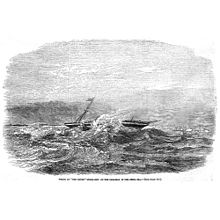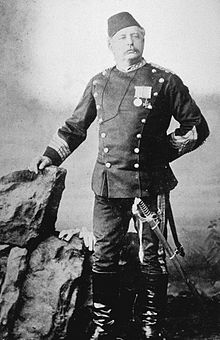|
Charles George Baker
Major General and Lewa Pasha Charles George Baker VC (8 December 1830 – 19 February 1906) was a British Merchant Navy officer, a Bengal Army officer, a Turkish Army officer, and head of the Egyptian Police. He was responsible for the rescue of the passengers and crew of the wrecked Steamship Douro. He was also a recipient of the Victoria Cross, the highest and most prestigious award for gallantry in the face of the enemy that can be awarded to British and Commonwealth forces. He subsequently went on to serve in the Turkish Army, becoming a Major General and Lewa Pasha. Following this he became head of the Egyptian Police Force. Early lifeCharles George Baker was born in Noacolly (Noakhali), Bengal, British India on 8 December 1830[1] to John and Lydia Baker from Suffolk. John Baker was a Doctor in the East India Company's Medical Service. The young Baker was sent to England to be educated, attending schools in Halesworth and Lowestoft in Suffolk.[2] Wreck of the Douro While an employee of the Peninsular and Oriental Steam Navigation Company in 1854, Baker was serving as Second Officer aboard the Douro, a passenger vessel. As the ship was sailing near the Paracel Islands it struck the north shoal and was wrecked. On 26 May, accompanied by seven volunteers, Baker took a Jolly boat and set out for Hainan which he estimated was 123 miles (198 km) away. According to the log he kept, on arrival at the island of Hainan they were unable to locate signs of habitation, so the decision was made by him to head for Hong Kong. The first vessels they encountered on their journey turned out to be pirates who refused food, water, and other assistance unless the crew allowed themselves to be stripped of all valuables. The boat was able to escape, facing adverse weather conditions and taking on water. After a journey totalling over 500 miles (800 km), the boat reached Hong Kong on the morning of 3 June. Baker reported the wreck, and was successful in securing rescue for the passengers and crew of the Douro, with the Steamships Malta, Tartar, and Pekin arriving at the site of the wreck on 5, 6 and 8 June respectively. The only loss of life from this incident was a member of the ship's crew who had fallen overboard.[3][4] Military serviceShortly afterwards Baker found employment in the East India Company's Bengal Army, eventually joining the Bengal Military Police Battalion under then-Captain Thomas Rattray. He was appointed as Second in Command of the Bengal Military Police Battalion on its formation, on 15 April 1856, while simultaneously holding the positions within the unit of Commandant of Cavalry and Officiating Commandant.[5] Baker served with them through the Indian Mutiny.[6] Victoria CrossHe was 27 years old, and a lieutenant during September 1858 when the cavalry portion of the Bengal Military Police Battalion was assigned to the Field Force commanded by Lieutenant-Colonel William West Turner CB, then responsible for the security of the Grand Trunk Road.[7] Baker's reportOn 27 September Lt. Baker sent the following despatch to Lt. Col. Turner, detailing action at Suhejnee (Sahejani), near Peroo (Piro), Bhojpur:
Further InformationOnly one man under Lt. Baker's command was killed during this action and 17 wounded[9] including George Bell Chicken, a civilian Master Mariner who was serving as a volunteer with the Naval Brigade. When the report of Lt. Baker's actions reached the Commander-in-Chief of the Army in India (General Campbell) he directed his Adjutant-General to write the following to the Governor-General, Lord Canning:
CitationFor his actions on that day Lieutenant Baker was awarded the Victoria Cross. His citation reads:
Date of actionIn the despatch sent by Lieutenant Baker to his superiors, the action is stated as taking place on 26 September 1858. The date noted in reports from his commanders, and the date noted in the London Gazette however, is 27 September 1858. The reason for this discrepancy is not known. Later careerAfter the Mutiny, Baker continued to serve with the Bengal Military Police Battalion, and took part in an 1861 Expedition to Sikkim.[12] In 1863 he was appointed as Officiating Deputy Inspector-General of Military Police for the Dacca Circle of Bengal.[12] After leaving India, he served in the forces of Sultan Abdul Hamid II under Valentine Baker in the Balkan theatre during the Russo-Turkish War, and was taken prisoner by the Russians. As a reward from the Sultan for his service in Turkey, Baker was given the rank of Major General and appointed Lewa Pasha. Baker then went with Valentine Baker to Egypt, working under him and eventually succeeding him as head of the Egyptian police force. He went on to become Chief of the Public Security Department of the Egyptian Ministry of the Interior, holding that post until his retirement in 1895.[12][13] RetirementAfter retiring from service with the Egyptian government, Major General Baker moved to Southbourne with his wife Charlotte, residing in the South Cliff Hotel on Belle Vue Road.[14] He died on 19 February 1906 in Southbourne, and was laid to rest in Christchurch Cemetery in Dorset. References
|
||||||||||||||||||||||
